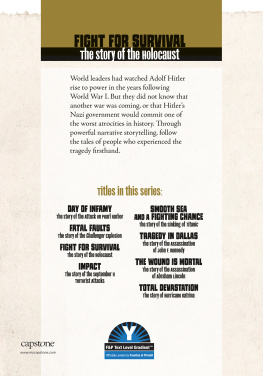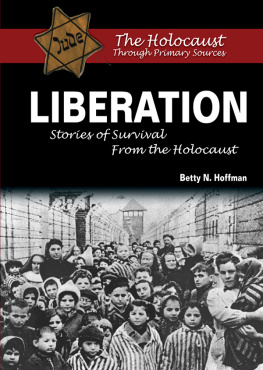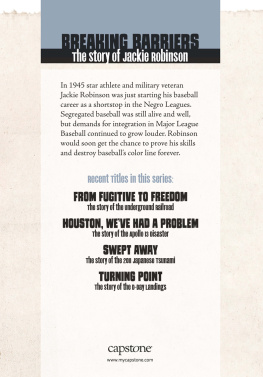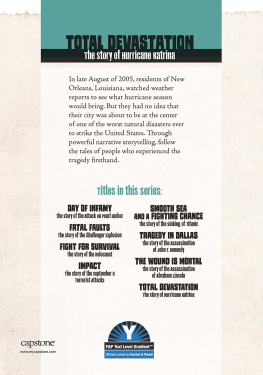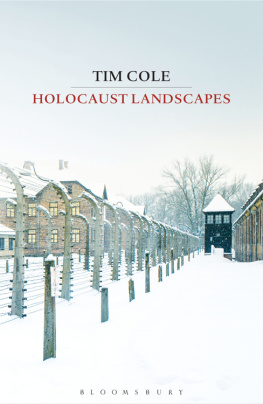Jessica Freeburg - Fight for Survival: The Story of the Holocaust
Here you can read online Jessica Freeburg - Fight for Survival: The Story of the Holocaust full text of the book (entire story) in english for free. Download pdf and epub, get meaning, cover and reviews about this ebook. year: 2016, publisher: Capstone, genre: Detective and thriller. Description of the work, (preface) as well as reviews are available. Best literature library LitArk.com created for fans of good reading and offers a wide selection of genres:
Romance novel
Science fiction
Adventure
Detective
Science
History
Home and family
Prose
Art
Politics
Computer
Non-fiction
Religion
Business
Children
Humor
Choose a favorite category and find really read worthwhile books. Enjoy immersion in the world of imagination, feel the emotions of the characters or learn something new for yourself, make an fascinating discovery.
- Book:Fight for Survival: The Story of the Holocaust
- Author:
- Publisher:Capstone
- Genre:
- Year:2016
- Rating:5 / 5
- Favourites:Add to favourites
- Your mark:
- 100
- 1
- 2
- 3
- 4
- 5
Fight for Survival: The Story of the Holocaust: summary, description and annotation
We offer to read an annotation, description, summary or preface (depends on what the author of the book "Fight for Survival: The Story of the Holocaust" wrote himself). If you haven't found the necessary information about the book — write in the comments, we will try to find it.
In an immersive, exciting narrative nonfiction format, this powerful book follows a selection of people who experienced the events of the Holocaust.
Fight for Survival: The Story of the Holocaust — read online for free the complete book (whole text) full work
Below is the text of the book, divided by pages. System saving the place of the last page read, allows you to conveniently read the book "Fight for Survival: The Story of the Holocaust" online for free, without having to search again every time where you left off. Put a bookmark, and you can go to the page where you finished reading at any time.
Font size:
Interval:
Bookmark:

As Allied forces moved across Europe in July 1944, they found one concentration campafter another. The Nazis tried to hide evidence of the mass murders they had committedand forced those prisoners who could still do so to march deeper into Germany. Manythousands died during these marches. By the time Allied troops found the camps, onlya small number of prisoners who had been too weak to march remained.
The soldiers were shocked at the sight of people so thin they hardly looked human.Even more shocking were the piles of bodies, left behind when the SS had run outof time to burn them. At Auschwitz, Allied soldiers discovered buildings filled withpersonal items taken from prisoners when they arrived. These items included hundredsof thousands of mens suits and more than 800,000 items of womens clothing. Stackedin bags were 14,000 pounds of human hair that the Nazis had been using to stuff intofurniture for padding.
On April 30, 1945, Russian troops were closing in on the bunker where Adolf Hitlerand his loyal staff and friends were hiding. Before the Russians arrived, Hitlerand his wife, Eva Braun, committed suicide. The next day, Joseph Goebbels and hiswife, Magda, tucked their six children into bed. As the children slept, a doctorput poison pills into their mouths. Then Goebbels and his wife committed suicide.
After being released from Dachau Concentration Camp in 1938, Arnold Blum emigratedto the United States. He enlisted in the army, returning to Germany before the warended to serve as a liaison between American soldiers and the Germans. While there,Blum learned about a former Nazi, Herr Schluemper, who had been bragging about beatingup Jews during Kristallnacht. One evening, Blum visited Schluempers home in thenearby town of Blumenthal to confront him. Schluemper confirmed he had been a Nazi,but denied any involvement in Kristallnacht. Blum declared that Schluemper was aliar before landing an uppercut against his chin. He left Schluemper in a heap onthe floor. Blum accomplished something few Holocaust survivors would ever enjoyasmall piece of retribution against someone whose hands had mercilessly beaten innocentJews.
After her liberation, Maria Blitz married and moved to America. Looking at her sons,she was reminded of the children, including her three-year-old niece, who had beenkept in the Krakow Ghetto. If their parents had known the Nazis would shoot themall before the day ended, they would have fought to protect them. But then they toowould have been killed that day.
Blitz was haunted by such memories and plagued with nightmares. Despite surviving,she felt a part of her was dead, murdered by the Nazis along with her family. Shemade it her goal to help others remember in the hope that such horrors would neverbe repeated.
In the summer of 1989, Fred Spiegel took his family on a trip to Europe so they couldbetter understand the life he lived, and the childhood he lost. They visited hisfathers and grandmothers graves and stopped by the memorial at Bergen-Belsen topay respects to the Jews buried in the mass graves there. Like ripping a bandageoff an old wound, the trip was painful but necessary.
On the 55th anniversary of Kristallnacht, Spiegel returned to Dinslaken, Germany,to participate in a ceremony, along with other survivors of the Jewish community,to unveil a memorial dedicated to the victims. By then, he was speaking at schoolsabout being a Holocaust survivor and the importance of forgiving but never forgetting.
Oliver Lustig served in the army for 37 years, working as a military journalist.He also earned a PhD in Economics. Lustig dedicated his life to helping others understandthe truth of what happened during the Holocaust. He wrote several books of his ownand translated Eva Heymans diary from Hungarian to Romanian as a labor of love tothe memory of all Holocaust victims.
All records of Herschel Grynszpan stopped in May of 1945. He was declared dead in1960 with his date of death noted as May 8, 1945.
For three and a half years, Dawid Sierakowiak fought to stay alive under unimaginablydifficult conditions, but on August 9, 1943, his death certificate was signed. Thecause of his death was tuberculosis, starvation, and exhaustion, or what became knownas ghetto disease.
The lives of Sierakowiak and Eva Heyman were destroyed by the Nazisalong with anestimated 11 million other innocent victims, 6 million of them Jewsbut the storiesof their struggles to survive live on in both of their diaries. They represent theplight of the estimated 1.5 million children who were murdered by the Nazis. Theycould never have known the impact their words would have on people all over the world.Their voices cry out from beyond the grave, Remember us! We lived!
Those who cannot remember the past are condemned to repeat it. George Santayana

On January 27, 1945, Soviet troops entered Auschwitz, freeing more than 7,000 prisoners.
- JULY 29, 1921: Hitler becomes the Fhrer (leader) of the National Socialist GermanWorkers (Nazi) party.
- APRIL 20, 1923: The Nazi newspaper Der Strmer begins publication of propaganda againstJews.
- JANUARY 30, 1933: German president Paul von Hindenburg names Hitler chancellor ofGermany.
- APRIL 1, 1933: Hitler declares a national boycott on Jewish businesses.
- APRIL 7,1933: German Jews are banned from the civil services.
- MAY 10, 1933: A nationwidebook burning of all books written by Jewish authors occurrs throughout Germany.
- AUGUST 2, 1934: German president Paul von Hindenburg dies; the office of presidentis abolished and its powers are combined with those of the chancellor, giving Hitlercomplete control of Germany.
- SEPTEMBER 15, 1935: Nuremberg Laws are instituted revokingGerman citizenship to Jews and prohibiting the marriage of Jews to non-Jewish Germans.
- NOVEMBER 14, 1935: Nuremberg Laws extend to others the Germans feel are racially inferior, including Roma (Gypsies) and blacks.
- NOVEMBER 7, 1938: Herschel Grynszpan shoots Ernst vom Rath at the German Embassyin Paris, France.
- NOVEMBER 9, 1938: Ernst vom Rath dies from the gunshot wounds inflicted by HershcelGrynszpan; Joseph Goebbels incites the destruction of Jewish property that becameknown as Kristallnacht.
- FEBRUARY 8, 1940: The Nazis officially announce that therewill be a ghetto established in Lodz to house the estimated 230,000 Jewish populationthere.
- MAY 1942: Herschel Grynszpan is transferred from Sachsenhausen Concentration Camp,and there is no further record of him after this point.
- SEPTEMBER 4, 1942: Chaim Rumkowski, the Jewish head of the Council of Elders in theLodz Ghetto, announces that the Nazis have ordered the transfer of about 25,000 ghettoinhabitants, mostly children and elders.
- JUNE 22, 1943: Germans surround the ghetto outside of Bedzin, Poland, and announcethat they will transport all Jews to Auschwitz Concentration Camp.
- MARCH 13, 1944: The liquidation of the Krakow Ghetto begins.
- APRIL 30, 1945: AdolphHitler and Eva Braun commit suicide.
- MAY 8, 1945: Nazi Germanys unconditional surrenderis accepted by the Allies, ending the war in Europe.
Font size:
Interval:
Bookmark:
Similar books «Fight for Survival: The Story of the Holocaust»
Look at similar books to Fight for Survival: The Story of the Holocaust. We have selected literature similar in name and meaning in the hope of providing readers with more options to find new, interesting, not yet read works.
Discussion, reviews of the book Fight for Survival: The Story of the Holocaust and just readers' own opinions. Leave your comments, write what you think about the work, its meaning or the main characters. Specify what exactly you liked and what you didn't like, and why you think so.

